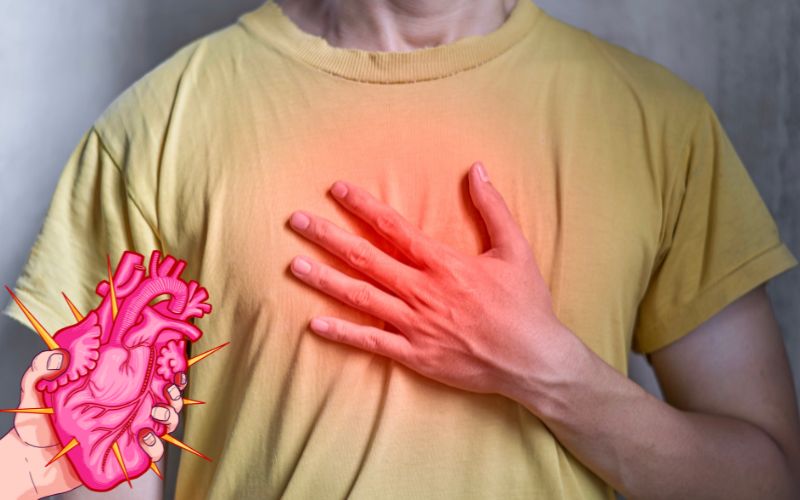Chest pain is one of the most alarming symptoms anyone can feel. It may start suddenly or grow slowly. Sometimes it feels sharp, other times dull or heavy. Chest pain can happen on the left, right, or center of the chest. It can be mild or severe, short or lasting. What makes it more complex is that chest pain can signal a heart problem—or something else entirely.
Many people worry about chest pain and heart attack, and rightly so. But not all chest pain means your heart is in danger. In fact, there are many chest pain due to non cardiac issues that are treatable and not life-threatening. Knowing what’s causing your chest pain is the first step to the right care.
In this article, we’ll explain what can lead to chest pain, how to tell the difference between serious and mild symptoms, and when to seek help. We’ll also guide you to the best care if you’re looking for a cardiology hospital in Delhi or need the best cardiologist in Delhi.
Common Causes of Chest Pain
Chest pain has many causes. Some come from the heart. Others are from muscles, lungs, stomach, or even anxiety. We can group the causes into two types: chest pain due to cardiac issues and chest pain due to non cardiac issues.
1. Chest Pain Due to Cardiac Issues
Heart-related chest pain is often the most dangerous. This pain means something may be wrong with the blood flow to the heart. Here are some common causes:
a. Heart Attack
A heart attack happens when blood flow to the heart stops. This causes damage to the heart muscle. The pain may feel like:
- Pressure or squeezing in the chest
- Pain spreading to the jaw, arm, or back
- Nausea, sweating, or shortness of breath
If you feel chest pressure that lasts more than a few minutes or comes and goes, get emergency help. It may be a chest pain and heart attack signal.
b. Angina
Angina is chest pain caused by reduced blood to the heart. It happens when your heart works harder, like during exercise. It often feels like tightness or burning. Rest or medicine usually helps.
c. Pericarditis
Pericarditis is swelling of the lining around the heart. It causes sharp pain that may feel worse when you lie down or breathe deeply. This can feel like chest pain while breathing and is often mistaken for lung pain.
If your symptoms match these, visit a heart hospital in Delhi for proper testing. The doctors may suggest ECG, blood tests, or a stress test to check your heart.
2. Chest Pain Due to Non Cardiac Issues
Not all chest pain is from the heart. Other organs in the chest—like the lungs, esophagus, or muscles—can also be the source.
a. Muscle Strain
A pulled chest muscle from lifting, coughing, or exercise can cause pain. This pain is sharp and gets worse when you move. You may feel chest pain on right or chest pain on upper ride depending on which side is hurt.
b. Gastroesophageal Reflux (GERD)
Acid reflux can cause a burning feeling in the chest. It may feel like a heart attack, but it is not. The pain often happens after meals or when lying down.
c. Lung Issues
Pneumonia, a collapsed lung, or a blood clot in the lung (pulmonary embolism) can all cause chest pain. The pain may feel sharp and get worse with deep breaths, leading to chest pain while breathing.
You may also feel chest pain on upper left or chest pain on left if the left lung is involved. If it’s the right lung, you’ll feel chest pain on upper ride.
d. Panic Attack
Anxiety can cause chest pain too. A panic attack brings fast heartbeat, sweating, and shortness of breath. It often feels like chest pressure or a tight band around the chest.
While not harmful, panic-induced chest pain should still be checked to rule out heart issues.
Location of Pain: What It May Mean
The side and area of chest pain give clues about the cause.
a. Chest Pain on Left
This is often linked with the heart. If it comes with shortness of breath, jaw or arm pain, it needs urgent care.
b. Chest Pain on Right
Usually not from the heart. It may be muscle strain, lung issues, or gallbladder problems.
c. Chest Pain on Upper Left
Could be from a lung infection, muscle pull, or heart lining inflammation.
d. Chest Pain on Upper Ride
Often linked with rib strain, right lung issues, or digestive problems. No matter the side, if the pain is new, severe, or lasts more than a few minutes, don’t ignore it.
When to See a Heart Doctor in Delhi
See a doctor right away if you have:
- Pain that spreads to arm, jaw, or back
- Chest pain that lasts more than a few minutes.
- Shortness of breath.
- Fast or irregular heartbeat
- Sweating or nausea
These may signal chest pain and heart attack.
If your pain is mild but keeps coming back, or if you feel chest pain while breathing, schedule a check-up. Early tests can prevent bigger issues later.
A good cardiology hospital in Delhi will offer ECG, stress test, echo, and blood checks. If needed, they may refer you to the best cardiologist in Delhi.
Chest pain should never be ignored. It may be from the heart—or not. But in both cases, early care is key. Keep track of your symptoms. If you feel chest pain on left, chest pain while breathing, or tightness that does not go away, visit a doctor without delay.
Looking for expert care? Kalra Hospital is among the trusted names for heart care in Delhi. We are a well-known heart hospital in Delhi. We have a full cardiac unit with trained specialists, modern tools, and fast diagnosis. Visit Kalra Hospital to learn more or to book your consultation.








